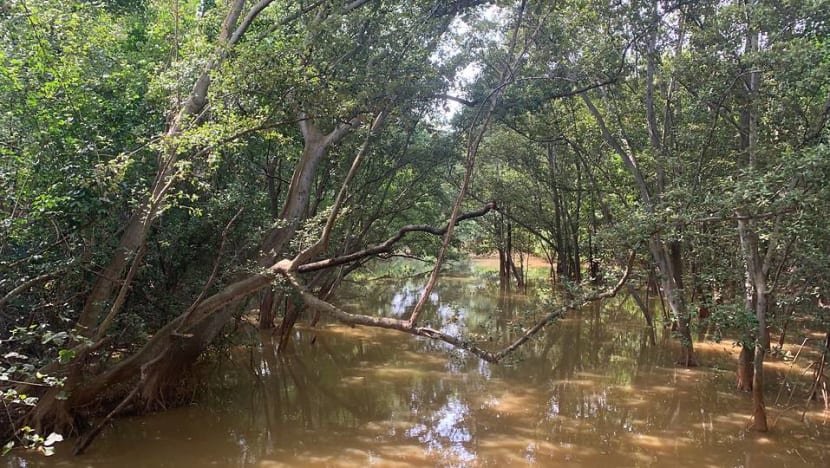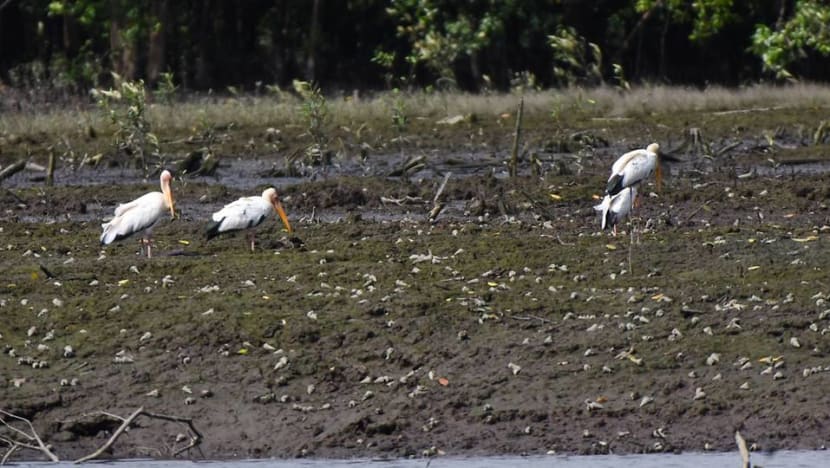Commentary: Mangroves, a crown jewel of Singapore’s coastline
Besides being incredibly biodiverse, Singapore’s mangroves work hard every day to support and protect us, says Dan Friess of NUS.

Early morning in the mangrove at Sungei Buloh Wetland Reserve. (Photo: Dan Friess)
SINGAPORE: Hundreds of millions of people in coastal communities across the tropics depend on mangrove forests for fisheries, fuel wood, medicines and coastal protection.
The huge importance of mangroves is commemorated every year on Jul 26, with the United Nations’ International Day for the Conservation of the Mangrove Ecosystem.
There is much to celebrate: Mangrove forests were previously considered one of the most threatened habitats on the planet, but international efforts have turned this habitat into an emerging conservation success story.
Globally, rates of mangrove loss have reduced dramatically. Mangroves were thought to have been lost at a rate of 1 to 3 per cent per year in the 1980s and 1990s, but a recent NASA study showed mangroves are only being lost at approximately 0.1 per cent per year today.
READ: How Singapore's mangroves can contribute in the battle against climate change
Reductions in deforestation rates are good news for the species living in mangroves, and Southeast Asia is a hotspot for biodiversity. In Singapore, our mangroves are some of the most biodiverse in the world, containing 35 out of the 70 mangrove plant species found around the world.
Our mangroves are home to a dazzling variety of animals, including insects, crabs, otters and crocodiles. Since the 1980s, at least 67 new species that are new to science were first discovered here in Singapore’s mangroves.
These include the mangrove crown crab (neorhynchoplax mangalis) first discovered in Mandai mangrove, and the rare cheryl crab (Praosia punctata) first found from a small mangrove creek in Sungei Buloh Wetland Reserve.
READ: Commentary: Excitement over marine creatures is great, but are we loving Singapore’s shores to death?
WORKING HARD BEHIND THE SCENES
Despite their small size, our research over the past decade or more has shown that Singapore’s mangroves and their biodiversity work hard behind the scenes every day to support and protect us.
Singapore’s mangroves help clean our environment. They trap heavy metals and pharmaceutical products in their soils, and they can take small particulates out of the air.
Most recently, mangroves have received a huge amount of attention for their role in climate change mitigation. Mangroves can suck up carbon dioxide from the atmosphere four times more efficiently than other forest types, and store that carbon for thousands of years in their waterlogged soils.

As a result, Singapore’s mangroves currently store more than 1.4 million tonnes of carbon dioxide, and continue to sequester more carbon every year. Singapore aims to peak greenhouse gas emissions at 65 million tonnes by 2030, and then halve peak emissions to 33 million tonnes by 2050, so nature-based solutions such as mangroves could make a small contribution to offsetting greenhouse gas emissions.
Mangroves can facilitate climate change adaptation and coastal protection too. During a large storm, some mangroves in Singapore can absorb more than 75 per cent of the energy of the incoming waves, protecting the shorelines and our assets behind them.
Over longer time periods, mangroves trap sediments floating in the water and use this to build up their surface elevations.
If there is sufficient sediment and mangroves can trap them at high rates, they can potentially keep pace with some rates of sea-level rise. Because of such sediment supply, projections suggest that some areas in the Indo-Pacific may not be susceptible to even extreme scenarios of sea-level rise by the end of the century.
Mangroves are now considered a key nature-based solution to coastal protection and climate change adaptation, and are being discussed in the context of Singapore’s long-term coastal adaptation planning.
READ: Commentary: How effectively can Singapore adapt to sea level rise?
READ: Commentary: As ice caps melt, Singapore a hot spot for sea-level rise
THE COMEBACK OF THE MANGROVE
While we now have a strong appreciation of the benefits that our mangroves provide, this perhaps hasn’t always been the case. Singapore’s mangrove extent declined by more than 80 per cent between 1958 and 2014.
Land reclamation led to substantial mangrove loss along the south coast of Singapore. For example, Pandan Nature Reserve was home to more than 200 ha of mangrove forest, but is now buried under Jurong Industrial Estate.
Damming up our mangrove-fringed estuaries into freshwater reservoirs led to the loss of large areas of mangroves in places such as Kranji. And conversion of mangroves into aquaculture ponds to produce fish and shrimp led to the loss of mangroves at Khatib Bongsu and Pulau Ubin.
Today, the jewel in the crown of our protected mangroves is Sungei Buloh Wetland Reserve, but even this wasn’t always the highly conserved mangrove forest that we now know and love.
In the 20th century, large areas of Sungei Buloh were converted to aquaculture production. It wasn't until the late 1980s that its importance for migratory bird life was recognised. 87 ha of land was then designated as the Sungei Buloh Nature Park, which became the basis for Sungei Buloh Wetland Reserve in 2002.

The newly announced Sungei Buloh Nature Park Network will triple the size of the current wetland reserve. It will incorporate new mangrove areas such as Mandai Mangrove, Mudflat Nature Park and Lim Chu Kang Nature Park over the coming years.
This is an exciting opportunity to make our mangroves more accessible to the public, and to meet the demand for nature recreation that our parks and natural areas have seen after circuit breaker.
READ: Sungei Buloh Nature Park Network to be established, includes new Lim Chu Kang Nature Park
BRINGING MANGROVE FORESTS BACK
Beyond preserving our existing mangroves, we can bring back the ones we have lost. But mangrove restoration isn’t as straightforward to do compared to other types of forests, because the plants need specific environmental conditions to grow.
Different mangrove species have different tolerances to waves, tidal flooding, and salinity. So, successful mangrove restoration requires us to restore the broader environment, and not just plant the trees.
READ: Commentary: Planting trees is a safe climate action but are its benefits inflated?
But we’ve shown we can do it on Pulau Semakau, where approximately 13 ha of mangroves were successfully replaced after being lost during reclamation works to construct our offshore landfill.
There are huge opportunities to do more. Approximately 75 ha of abandoned aquaculture ponds lie across Singapore. By restoring these ponds back to their original mangrove cover, we could increase Singapore’s national mangrove area by as much as 10 per cent.
Community-based groups such as the Restore Ubin Mangroves Initiative are working with government stakeholders to assess the feasibility of restoring some of these abandoned pond areas on Pulau Ubin.
In areas without sufficient space for mangrove restoration, we can consider novel hybrid engineering solutions. For example, mangrove saplings have been incorporated into coastal defence structures on Pulau Tekong.

Such hybrid engineering solutions can reduce the resources needed for building man-made defences, with smaller defence structures and lower maintenance costs over the long term.
WORKING TO SECURE THE FUTURE OF OUR MANGROVE FORESTS
While we have achieved great conservations successes in Singapore and globally, these gains are not guaranteed. Some mangrove areas may be at risk from potential land reclamation over the next 10 to 15 years, according to the Urban Redevelopment Authority’s 2019 Master Plan.
Mangroves are also on the front line in the battle against climate change. While they can help protect us from sea-level rise, they are also heavily affected by it. If we can alleviate some of the other human pressures our mangroves face, then we can make them more resilient and give them a fighting chance against climate change.
READ: Salty rivers, failed durian trees and waves consuming the shore: Climate change realities hit Gulf of Thailand
Despite these challenges, previous efforts to save this crucial habitat in Singapore mean we have a strong foundation upon which to build our future conservation successes, and to make mangroves a key part of our future shorelines.
For now, let’s celebrate our mangrove forests, the benefits they provide to all of us, and the stakeholders from across society who have made their conservation and restoration possible.
Dan Friess is an Associate Professor at the Department of Geography, National University of Singapore, and Deputy Director of the NUS Centre for Nature-based Climate Solutions.















